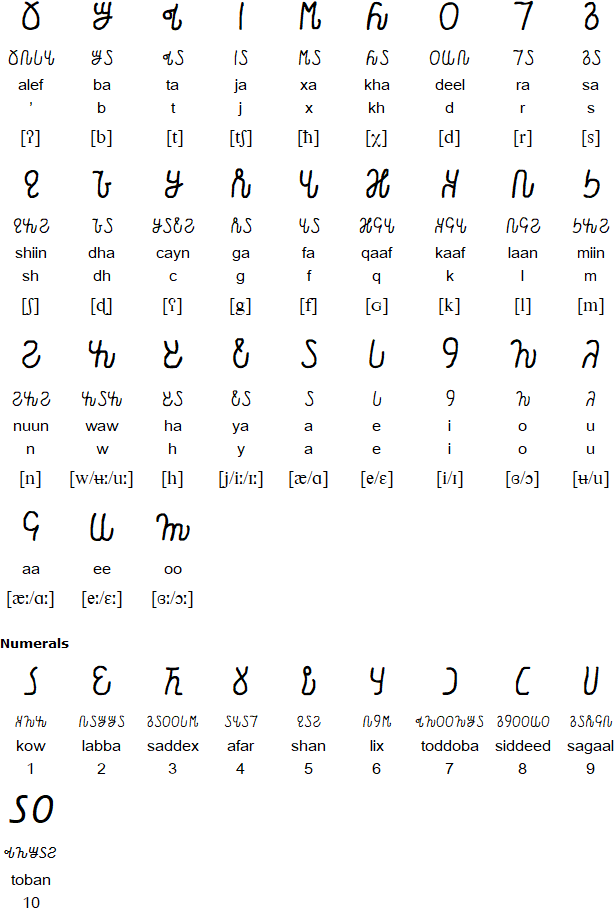The Osmanya alphabet was created in between 1920 and 1922 by Osman Yusuf Kenadid (Cusmaan Yuusuf Keenadiid / عثمان يوسف), brother of the Sultan of Obbia. In Somali it is known as farta cismaanya / 𐒍𐒖𐒇𐒂𐒖 𐒋𐒘𐒈𐒑𐒛𐒒𐒕𐒖 (Somali writing) or Far Soomaali / 𐒍𐒖𐒇 𐒘𐒝𐒈𐒑𐒛𐒘 (Somali writing). It replaced an attempt by Sheikh Uweys to devise an Arabic-based alphabet for Somali, and has in turn been replaced by the Latin orthography devised by Shire Jama Ahmed, a Somali linguist, in 1972.
The Osmanya alphabet is also known as the Somali alphabet. It is not used much these days, although during the 1970s quite a number of people used it for personal correspondence and bookkeeping. A few books and magazines have also been published in the alphabet.

Download alphabet charts for Osmanya

Aadanaha dhammaantiis wuxuu dhashaa isagoo xor ah kana siman xagga sharafta iyo xuquuqada Waxaa Alle (Ilaah) siiyay aqoon iyo wacyi, waana in qof la arkaa qofka kale ula dhaqmaa si walaaltinimo ah.
All human beings are born free and equal in dignity and rights. They are endowed with reason and conscience and should act towards one another in a spirit of brotherhood.
(Article 1 of the Universal Declaration of Human Rights)
Information about Somali | Osmanya alphabet | Borama / Gadabuursi alphabet | Kaddare alphabet | Phrases | Numbers | Tower of Babel | Books about Somali on: Amazon.com and Amazon.co.uk [affilate links]
Information about the Osmanya alphabet
https://en.wikipedia.org/wiki/Osmanya_alphabet
https://so.wikipedia.org/wiki/Farta_Cismaaniya
https://thelanguagecloset.com/2023/01/07/writing-in-africa-the-somalian-alphabets-pt-2/
Free Osmanya fonts
http://www.wazu.jp/gallery/Fonts_Osmanya.html
https://fonts.google.com/noto/specimen/Noto+Sans+Osmanya
Online Osmanya keyboard
https://www.lexilogos.com/keyboard/osmanya.htm
Latin-Osmanya transliterator
https://somali.surge.sh/
A-chik Tokbirim, Adinkra, ADLaM, Armenian, Avestan, Avoiuli, Bactrian, Bassa (Vah), Beitha Kukju, Beria (Zaghawa), Borama / Gadabuursi, Carian, Carpathian Basin Rovas, Chinuk pipa, Chisoi, Coorgi-Cox, Coptic, Cyrillic, Dalecarlian runes, Elbasan, Etruscan, Faliscan, Fox, Galik, Georgian (Asomtavruli), Georgian (Nuskhuri), Georgian (Mkhedruli), Glagolitic, Global Alphabet, Gothic, Greek, Hurûf-ı munfasıla, Irish (Uncial), Kaddare, Kayah Li, Khatt-i-Badí’, Khazarian Rovas, Koch, Korean, Latin, Lepontic, Luo Lakeside Script, Lycian, Lydian, Manchu, Mandaic, Mandombe, Marsiliana, Medefaidrin, Messapic, Mongolian, Mro, Mundari Bani, Nag Chiki, Naasioi Otomaung, N'Ko, North Picene, Novo Tupi, Nyiakeng Puachue Hmong, Odùduwà, Ogham, Old Church Slavonic, Oirat Clear Script, Ol Chiki (Ol Cemet' / Santali), Old Italic, Old Nubian, Old Permic, Ol Onal, Orkhon, Osage, Oscan, Osmanya (Somali), Pau Cin Hau, Phrygian, Pollard script, Runic, Székely-Hungarian Rovás (Hungarian Runes), South Picene, Sutton SignWriting, Sunuwar, Tai Viet, Tangsa, Todhri, Toto, Umbrian, (Old) Uyghur, Wancho, Yezidi, Zoulai
Page last modified: 27.06.23
[top]
You can support this site by Buying Me A Coffee, and if you like what you see on this page, you can use the buttons below to share it with people you know.

If you like this site and find it useful, you can support it by making a donation via PayPal or Patreon, or by contributing in other ways. Omniglot is how I make my living.
Note: all links on this site to Amazon.com, Amazon.co.uk
and Amazon.fr
are affiliate links. This means I earn a commission if you click on any of them and buy something. So by clicking on these links you can help to support this site.
[top]